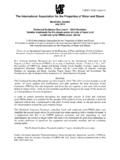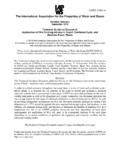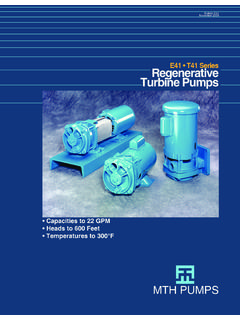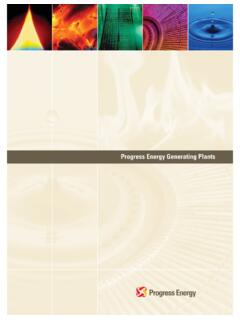Transcription of Technical Guidance Document: Steam Purity for Turbine ...
1 IAPWS TGD5-13. The International Association for the Properties of Water and Steam London, United Kingdom September 2013. Technical Guidance document : Steam Purity for Turbine Operation 2013 International Association for the Properties of Water and Steam Publication in whole or in part is allowed in all countries provided that attribution is given to the International Association for the Properties of Water and Steam President: Professor Tamara Petrova Moscow Power Engineering Institute Moscow, Russia Executive Secretary: Dr. R. B. Dooley Structural Integrity Associates Email: This document contains 37 pages, including this cover page. This Technical Guidance document has been authorized by the International Association for the Properties of Water and Steam (IAPWS) at its meeting in London, UK, 1 6 September 2013, for issue by its Secretariat. The members of IAPWS are: Britain and Ireland, Canada, the Czech Republic, Germany, Japan, Russia, Scandinavia (Denmark, Finland, Norway and Sweden), and the United States of America, and Associate Members Argentina and Brazil, Australia, France, Greece, Italy, New Zealand and Switzerland.
2 The document represents the accumulated experience of the IAPWS Power Cycle Chemistry (PCC) Working Group with representation from 17 countries. This Technical Guidance document considers Steam turbines from power plants using fossil, combined cycle, nuclear, alternative and geothermal energy, including turbines in industrial applications. It is emphasized that this is an IAPWS Technical Guidance document and that, depending on local requirements, the normal or target values will need to be customized for each case, depending on the actual conditions of operation, the type of generation and use of the Steam , and the power cycle chemistry. Further information about this Technical Guidance document and other documents issued by IAPWS can be obtained from the Executive Secretary of IAPWS or from Contents 1 Nomenclature and Definitions ..3 2 Introduction: Purpose of document and How to Use it.
3 5 3 Background ..7 Chemical Environment in the Steam Turbine ..8 Path of Impurities into the Steam ..8 Nucleation of Early Condensate Droplets ..8 Formation of Liquid Films on PTZ Surfaces ..9 Influence of Steam Purity on Early Condensate Nucleation and Liquid Films ..10 Deposition ..10 Shutdown Damage Mechanisms in the Steam Turbine ..12 Deposits ..12 Corrosion ..13 4 Guidance to Limit the Effects of Poor Steam Steam Purity Parameters ..14 Impurities ..14 Conditioning Agents ..16 Monitoring Instrumentation ..17 Layup ..17 Mitigating Consequences of Sub-optimum Steam Chemistry ..17 5 Table of Chemistry Limits ..19 Table of Steam Purity Limits ..19 Condensing Turbines with Superheated Steam ..19 Condensing Turbines with Saturated Steam ..19 Limits for Normal Operation ..19 Development of Limits for Development of Action Levels ..21 Development of Shutdown Limits ..21 6 Road Map Approach to Customize Steam Purity Limits to Plants with Specific Features.
4 22 Turbines for Cycling or Peaking Operation ..22 Turbines with Extended Periods of Shutdown ..23 Backpressure Turbines ..23 Turbines for Industry and Process Turbines with Solar and Biomass Steam Generating Systems ..26 Turbines with Geothermal Steam ..26 Turbines with Steam Generated in Nuclear Power Ultrasupercritical Turbines with Steam Temperatures above 600 C ..29 Turbines in Plants with Boilers using Phosphate Treatment ..29 Turbines with Steam containing Elevated Levels of Carbon Dioxide ..30 Turbines with Steam containing Organic Decomposition Turbines with Steam containing Elevated Levels of Silica ..31 Turbines in Power Cycles containing Major Components with Copper or Aluminum ..32 7 Bibliography and References ..33 2. 1 Nomenclature and Definitions Term Alternative or Definition Acronym All-volatile AVT Conditioning regime in which only volatile Treatment alkalizing agents are added to the feedwater (commonly ammonia, but volatile amines may also be employed).
5 May be either: AVT(R) Reducing conditions (added reducing agent). or AVT(O) Oxidizing conditions (without reducing agent). Attemperator Device for controlling superheater and reheater outlet temperature by spraying feedwater (or condensate or degassed demineralized water) into Steam Condensate Water that derives from condensation of Steam after expansion in a Steam Turbine and passage through a condenser or process heat exchanger Conductivity Specific Electrical conductivity of the water sample as Conductivity measured directly without any treatment1. Direct Conductivity Conductivity after CACE Conductivity of a water sample after passage cation exchange through a strongly acidic cation exchanger in the Cation hydrogen form Conductivity Acid Conductivity Caustic Treatment CT Involves addition of NaOH to the boiler or HRSG. evaporator Hydroxide Dosing Corrosion Fatigue CF Mechanical degradation of a material under the combined action of corrosion and cyclic loading Degassed Degassed Cation Conductivity after cation exchange of a sample conductivity after Conductivity from which volatile weak acids (predominantly cation exchange carbonic acid) have been stripped Drum boiler or Boiler in which Steam (generated in heated HRSG (drum-type) evaporator tubes) is separated from water in an unheated horizontal pressure vessel (drum).
6 The liquid phase is recirculated to the evaporator. Feedwater Water that is pumped into a boiler or HRSG to balance the Steam production 3. Term Alternative or Definition Acronym Flow-accelerated FAC In this document it is understood as accelerated Corrosion chemical dissolution of magnetite on the surface of carbon steel components as a result of flow Heat Recovery HRSG Steam generator using heat transfer from the Steam Generator exhaust gas of a combustion (gas) Turbine High Cycle Fatigue HCF Cracking induced by frequent reversals of stress such as vibration of Turbine blades Ion Chromatography IC An analytical technique to analyze for cations and anions in water Once-through boiler Boiler in which output Steam is generated from or HRSG input water by complete evaporation. There is no recirculation of boiler water. Oxygenated OT Conditioning regime in which oxygen and Treatment ammonia are added to the feedwater Parts per billion ppb, g/kg In this document , computed as mass fraction of a constituent in Steam or in water (mass of Parts per million ppm, mg/kg constituent per total mass).
7 Phase-transition PTZ Region in low pressure Steam Turbine where liquid Zone droplets begin to form from the Steam Pitting Extremely localized corrosion that leads to the creation of holes in the metal Phosphate PT Conditioning regime for drum boilers in which Treatment alkalinity is achieved by dosing the boiler water with tri-sodium phosphate Stress Corrosion SCC A cracking mechanism that occurs in the Steam Cracking Turbine phase transition zone. Swallowing capacity Flow passing A measure of the volumetric capacity of the ability Turbine to accept a Steam flow, usually referred to the maximum possible Steam flow at nominal pressure and temperature. Tri-sodium TSP Alkalizing boiler water treatment chemical phosphate 4. 2 Introduction: Purpose of document and How to Use it The purpose of this document is to provide Guidance on the development of Steam Purity limits to assist operators of a broader suite of generating plants in minimizing equipment damage and loss of efficiency, and in maximizing plant reliability.
8 The Guidance document can form the basis of, but should not restrict, other derivative guidelines around the world. IAPWS has issued a series of Technical Guidance Documents for the Steam cycle chemistry control of conventional fossil and combined cycle ,3,4,5 The volatile treatment and phosphate/caustic documents include limits for Steam Purity . The purpose of this document is to provide further Guidance on the development of Steam Purity limits to assist operators of a broader suite of generating plants in minimizing equipment damage and loss of efficiency, and in maximizing plant reliability. To avoid the major types of damage in the Steam turbines, equal emphasis must be given to the operating as well as to startup and shutdown environments, and these are discussed within this document . The Guidance can be used directly by chemists and plant operators, and to develop international, national, company and manufacturer's guidelines.
9 It should be noted that the Guidance for feedwater and boiler treatments of conventional and combined cycle/HRSG. plants have been published in other IAPWS Technical Guidance Documents4,5 and the Normal/Target values for feedwater and boiler water remain the same. The primary purposes of this document are to: a) highlight the problems which can exist in Steam turbines, b) indicate how these problems occur and can be avoided, c) provide a set of normal Steam Purity limits that will provide optimum protection for power plants using fossil, nuclear, alternative and geothermal energy, including turbines in industrial applications, and d) provide sufficient discussion that the reader can customize these normal values to actual plant configurations. The IAPWS experiences with Steam Purity are covered within this document , but a number of initial general principles and comments are delineated here: a) The success of any Steam Purity Guidance and limits ultimately depends on the operating experience and the lack of any serious failures, damage and deposits.
10 Thus the Guidance must be linked closely with comprehensive inspections during shutdown periods. Deposit samples should be carefully taken from each Turbine stage, and analysis results should include elemental, compound and metallurgical assessments. b) It is important to note the locations and topography of deposits when they are removed. In the low pressure (LP) Turbine it is important to note both the stage in relation to the Mollier diagram for expansion and the locations on the blade profile. 5. Any signs of pitting should also be recorded. The locations of deposits in high pressure (HP) and intermediate pressure (IP) sections should also be noted carefully. c) For drum type units, it is of paramount importance that carryover is measured on a frequent basis according to the IAPWS Technical Guidance This is particularly important when phosphate and NaOH alkalizing chemicals are added to the boiler/HRSG evaporator water, because elevated carryover can be a major source of corrosive impurities in the Steam .













